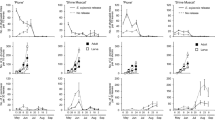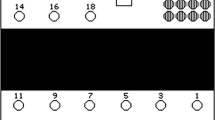Abstract
Surveys of thrips and Tomato spotted wilt virus (TSWV) on weeds were conducted in the eastern Mediterranean region of Turkey during the years 2004–2006. Thrips species were collected by vigorously shaking weedy plants into a white container for 15 sec. Plant material collected during field surveys and plants which were used for mechanical inoculation of TSWV, were tested by DAS–ELISA. The weed species Ranunculus muricatus, Melilotus officinalis, Sinapis arvensis and Portulaca oleracea were used for the virus transmission experiments in an enclosed high plastic tunnel and in cage experiments. Western flower thrips, Frankliniella occidentlis (Pergande) (Thysanoptera: Thripidae), was the most common thrips, inhabiting 80 of the 82 weed species sampled. Adults of F. occidentalis and thrips larvae were significantly more abundant on S. arvensis than on the other weed species sampled (P<0.05). Adult and larval thrips showed peak densities on most weeds in April or May. Summer annual weeds were not good hosts for reproduction of the thrips. A total of 90 samples from 17 plant species belonging to 11 plant families were ELISA positive for TSWV. No TSWV was detected on 65 weed species belonging to 26 plant families. High numbers of plant samples infected by TSWV were obtained in P. oleracea (21 samples) and in R. muricatus (15 samples). In field surveys symptoms of TSWV were detected on only R. muricatus. Incidence of the TSWV on weeds ranged between 5% and 25%. Transmission rates of TSWV by F. occidentalis to the weeds ranged from 33% to 83% in the pepper plastic tunnel and cage experiments.




Similar content being viewed by others
References
Arli-Sokmen, M., Mennan, H., Sevik, M. A., & Ecevit, O. (2005). Occurrence of viruses in field-grown pepper crops and some of their reservoir weed hosts in Samsun, Turkey. Phytoparasitica, 33, 347–358.
Atakan, E. (2008a). Thrips (Thysanoptera) species occurring on winter vegetable crops in Çukurova region of Turkey. Acta Phytopathologica et Entomologica Hungarica, 43, 227–234.
Atakan, E. (2008b). Thrips (Thysanoptera) species occurring on fruit orchards in Çukurova region of Turkey. Acta Phytopathologica et Entomologica Hungarica, 43, 235–242.
Atakan, E. (2010). Thysanoptera (Thrips) species and predatory insects associated with summer vegetable crops in the Çukurova region of Turkey. (pp. 416-422) In F. Yaşar, Ş. Çavuşoğlu, & M. Biçim (Eds.), Proceedings of the 8 th Symposium on Vegetables (Van, Turkey) (in Turkish, with English abstract).
Atakan, E., & Uygur, S. (2004). Seasonal abundance of some thrips species and their predators on weeds. Türkiye Entomoloji Dergisi, 28, 123–132 (in Turkish, with English abstract).
Atakan, E., & Uygur, S. (2005). Winter and spring abundance of Frankliniella spp. and Thrips tabaci Lindeman (Thysan., Thripidae) on weed host plants in Turkey. Journal of Applied Entomology, 129, 17–26.
Bailey, S. F. (1935). Thrips as vectors of plant diseases. Journal of Economic Entomology, 28, 856–863.
Bitterlich, I., & MacDonald, L. S. (1993). The prevalence of tomato spotted wilt virus in weeds and crops in southern British Columbia. Canadian Plant Disease Survey, 73, 137–142.
Chatzivassiliou, E. K., & Boubourakas, E. K. (2001). Weeds in greenhouses and tobacco fields are differently infected by tomato spotted wilt virus and infested by its vector species. Plant Disease, 85, 40–46.
Chellemi, D. O., Funderburk, J. E., & Hall, D. W. (1994). Seasonal abundance of flower-inhabiting Frankliniella species (Thysanoptera: Thripidae) on wild plant species. Environmental Entomology, 23, 337–342.
Childers, C. C., & Achor, D. S. (1995). Thrips feeding and oviposition injuries to economic plants, subsequent damage, and host responses to infestation. In B. L. Parker, M. Skinner, & T. Lewis (Eds.), Thrips biology and management (pp. 31–51). New York, NY: Plenum Press.
Cho, J. J., Mau, R. F. L., Gonsalves, D., & Mitchell, W. C. (1986). Reservoir weed hosts of tomato spotted wilt virus. Plant Disease, 70, 1014–1017.
Clark, M. F., & Adams, A. N. (1977). Characteristics of the micro plate method of enzyme linked immunosorbent assay for the detection of plant viruses. Journal of General Virology, 34, 475–483.
Daughtrey, M., Jones, R. K., Moyer, J. W., Daub, M. E., & Baker, J. R. (1997). Tospoviruses strike the greenhouse industry. Plant Disease, 81, 1220–1235.
Duffus, J. E. (1971). Role of weeds in the incidence of virus diseases. Annual Review of Phytopathology, 9, 319–340.
Francki, R. I., & Hatta, B. T. (1981). Tomato spotted wilt virus (pp. 491-512). In E. Kurstak (Ed.), Handbook of plant virus infections: Comparative diagnosis. New York, NY: Elsevier North Holland Biomedical Press.
German, T. L., Ulmann, D. E., & Moyer, J. W. (1992). Tospoviruses: diagnosis, molecular virology, phylogeny and vector relationship. Annual Review of Phytopathology, 30, 315–348.
Goldbach, R., & Peters, D. (1994). Possible causes of the emergence of tospovirus disease. Seminar of Virology, 5, 113–120.
Groves, R. L., Walgenbach, J. F., Moyer, J. W., & Kennedy, G. G. (2002). The role of weed hosts and tobacco thrips, Frankliniella fusca, in the epidemiology of Tomato spotted wilt virus. Plant Disease, 86, 573–582.
Groves, R. L., Walgenbach, J. F., Moyer, J. W., & Kennedy, G. G. (2003). Seasonal dispersal patterns of Frankliniella fusca (Thysanoptera: Thripidae) and Tomato spotted wilt virus occurrence in Central and Eastern North Carolina. Journal of Economic Entomology, 96, 1–11.
Güldür, M. E., Marchoux, G., Yurtmen, M., & Yılmaz, M. A. (1995). A new virus destructive on tomatoes growing in Mersin and its provinces: tomato spotted wilt virus (TSWV). pp. 303-305 In: Proceedings of the 7 th Turkish National Congress of Phytopathology (Adana, Turkey) (in Turkish, with English abstract).
Kirk, W. D. J., & Terry, L. I. (2003). The spread of the western flower thrips, Frankliniella occidentalis (Pergande). Agriculture and Forestry Entomology, 5, 301–310.
Latham, L. J., & Jones, R. A. C. (1997). Occurrence of tomato spotted wilt tospovirus in native flora, weeds and horticultural crops. Australian Journal of Agricultural Research, 48, 359–369.
Mandal, B., Csinos, A. S., Martinez-Ochoa, N., & Pappu, H. (2001). A rapid and efficient inoculation method for tomato spotted wilt tospovirus. Journal of Virological Methods, 149, 195–198.
Mantel, W. P., & van de Vrie, M. A. (1988). Contribution to knowledge of Thysanoptera in ornamental and bulbous crops in the Netherlands. Acta Phytopathologica et Entomologica Hungarica, 23, 301–311.
Özdemir, S., Erilmez, S., & Kaçan, K. (2009). Detection of Tomato spotted wilt virus (TSWV) on tomato crops and some weeds in Denizli province of Turkey. Acta Horticulturae (ISHS), 808, 171–174.
Parella, M. P., & Murphy, B. (1996). Western flower thrips, identification, biology and research on the development of control strategies. Bulletin IOBC/WPRS, 19, 115–118.
Peters, D. (1998). An updated list of plant species susceptible to tospoviruses (pp. 107-110). In Fourth International Symposium on Tospovirus and Thrips in Floral and Vegetable Crops (Wageningen, the Netherlands).
Power, A. G. (1992). Patterns of virulence and benevolence in insect-borne pathogens of plants. Critical Reviews in Plant Sciences, 11, 351–372.
Roggero, P., & Pennazio, S. (1997). Thermal inactivation of tomato spotted wilt tospovirus in vivo. Physiological and Molecular Plant Pathology, 51, 35–40.
Sakimura, K. (1962). The present status of thrips-borne disease. In K. Maramorsch (Ed.), Biological transmission of disease agents (pp. 33–40). London, UK: Academic Press.
Stobbs, L. W., Broadbent, A. B., Allen, W. R., & Stirling, A. L. (1992). Transmission of tomato spotted wilt virus by the western flower thrips to weeds and native plants found in southern Ontario. Plant Disease, 76, 23–29.
Tommasini, G. M., & Maini, S. (1995). Frankliniella occidentalis and other thrips harmful to vegetable and ornamental crops in Europe (pp. 1-41). In A. J. M. Loomans, J. C. van Lenteren, M. G. Tommasini, S. Maini, & J. Riudavets (Eds.), Biological control of thrips pests. Wageningen Agricultural University Papers, 95.I. Wageningen, the Netherlands.
Tunç, I., & Göçmen, H. (1994). New greenhouse pests, Polyphagotarsonemus latus and Frankliniella occidentalis in Turkey. FAO Plant Protection Bulletin, 42, 218–220.
Turhan, P., & Korkmaz, S. (2006). Determination of Tomato spotted wilt virus using serological and biological methods in tomatoes grown in Çanakkale Province, Turkey. Journal of Agricultural Science, 12, 130–136.
Ullman, D. E. (2010). Thrips vectors and tospoviruses: the rendezvous with destiny. In D. Persley, C. Wilson, J. Thomas, M. Sharman, & D. Tree (Eds.), IXth International Symposium on Thysanoptera and Tospoviruses (2009, Australia). Journal of Insect Science, 10/166, 51 (abstract).
Ullman, D. E., Cho, J. J., Mau, R. F. L., Hunter, W. B., Westcot, D. M., & Custer, D. M. (1992a). Thrips–tomato spotted wilt virus interactions: morphological, behavioral and cellular components influencing thrips transmission. In K. F. Harris (Ed.), Advances in disease vector research (pp. 195–240). New York, NY: Springer-Verlag.
Ullman, D. E., Cho, J. J., Mau, R. F. L., Westcot, D. M., & Custer, D. M. (1992b). A midgut barrier to Tomato spotted wilt virus acquisition by adult western flower thrips. Phytopathology, 82, 1333–1342.
Whitfield, A. E., Ullman, D. E., & German, T. L. (2005). Tospovirus–thrips interactions. Annual Review of Phytopathology, 43, 459–489.
Yardımcı, N., & Kılıç, H. Ç. (2009). Tomato spotted wilt virus in vegetable growing areas in the west Mediterranean region of Turkey. African Journal of Biotechnology, 8, 4539–4541.
Yudin, L. S., Tabashnik, B. E., Cho, J. J., & Mitchell, W. C. (1986). Host range of western flower thrips Frankliniella occidentalis (Thysanoptera: Thripidae), with special reference to Leucaena glauca. Environmental Entomology, 15, 1292–1295.
Acknowledgments
Our thanks are expressed to Dr. W. Thomas Lanini (University of California, Davis, CA, U.S.A.) and Dr. Ben Faber (University of California Cooperative Extension, Ventura, CA, U.S.A.) for reading and English corrections of an earlier draft of the manuscript; and to Asime Filiz Çalışkan (Institute of Basic and Applied Sciences, Çukurova University, Adana, Turkey) for her assistance in laboratory work. We also thank anonymous reviewers for their valuable comments and suggestions which improved the manuscript. This study was funded by TUBITAK (Council of Science and Technology of Turkey, Project no. TOGTAG-3238).
Author information
Authors and Affiliations
Corresponding author
Rights and permissions
About this article
Cite this article
Atakan, E., Kamberoğlu, M.A. & Uygur, S. Role of weed hosts and the western flower thrips, Frankliniella occidentalis, in epidemiology of Tomato spotted wilt virus in the Çukurova region of Turkey. Phytoparasitica 41, 577–590 (2013). https://doi.org/10.1007/s12600-013-0318-9
Received:
Accepted:
Published:
Issue Date:
DOI: https://doi.org/10.1007/s12600-013-0318-9




